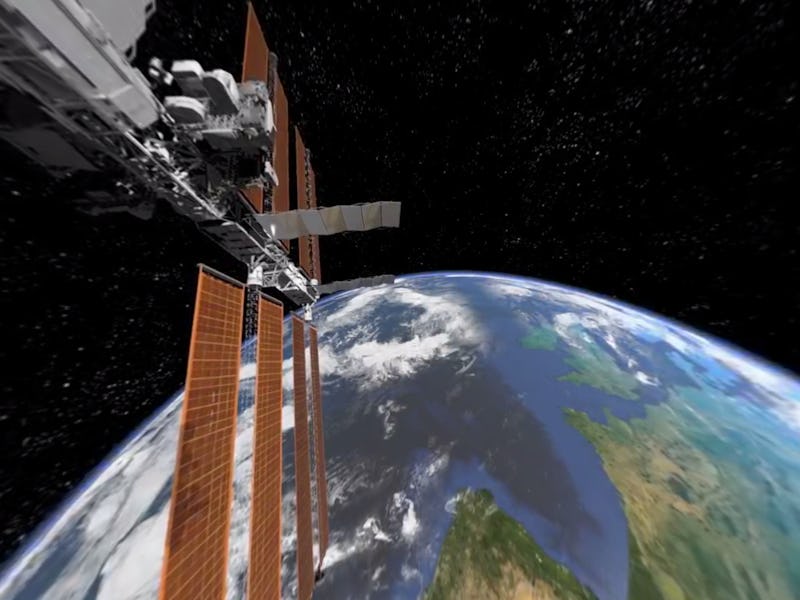The Science Channel's 'Secret Space Escapes' VR Experience Uses CGI for Good
The VR companion to the Science Channel's new show lets viewers experience the show in an all new way.

While social media blew up this weekend because of the New York Times’ nifty new VR platform, the Science Channel was preparing to unveil its own foray into virtual reality, a companion piece to the upcoming eight-part series Secret Space Escapes, premiering tonight at 10 p.m. The TV show chronicles the most harrowing moments in space travel — the premiere episode is about fires on the Mir space station — but the VR extension, “Spacewalk Mayday,” owes as much to Gravity as to NASA. Turns out that’s a good thing.
Users find themselves dodging errant debris while tethered to the International Space Station. The whole thing lasts only minutes, but it’s enough to give viewers a sense of the danger of space travel, an important reminder that exploration isn’t just about presidential commendations and cool patches.
“My hope is that when people experience that visceral emotional attachment to the VR, the stories they’re watching on the TV series operate on a completely different emotional level triggered by being in that situation,” Bernadette McDaid, vp of production for the Science Channel, told Inverse.
The team at the Discovery Communications (which owns the Science Channel and other similar outlets) have been busy building the Discovery VR platform for some time. Currently there are a bevy of real-life VR experiences on the platform including clips that allow the viewers to skateboard around the streets of San Francisco, take a surfing lesson with a big wave pro, and explore a shark-infested shipwreck with the Mythbusters team. There’s also the opportunities to prospect for gold with the guys from Gold Rush and traverse a swamp with Survivorman Les Stroud. It’s a lot and much of that content feels very first wave. The Secret Space Escapes experience doesn’t, largely because it’s less performative. The details here came from actual astronauts.
The experience is based on the experience of astronaut Scott Parazynski, who had to repair broken but still electrified solar panels on the International Space Station. Because the panels were electrified, that was an immensely dangerous moment for both Parazynski and the ISS crew. It fell to McDaid to speak with Parazynski about the realism of the project.
“It’s really such a love fest to NASA and to other space agencies all around the world,” says McDaid “While we’ve created an incredibly powerful and dramatic VR experience, it’s all based on actual science. That was important to me. There’s always a little bit of artistic license, but I wanted to make sure that it has integrity as a real experience.”
Former NASA Astronaut's Scott Parazynski, Robert Curbeam and Science Channel vice president of production Bernadette McDaid
Discovery VRs “Spacewalk Mayday” is also the first full CGI narrative experience, which McDaid sees as both a continuation of and a new way to tell a story. “I love VR so much because it democratizes the experience,” she says. “In this case the fact that we can provide people the experience with the thrill of the spacewalk and hopefully capture the fear as it goes wrong — that’s pretty exceptional.”
The short clip was created in collaboration with Ignis VR, a company based in the Netherlands. To access the VR experience, users can download the DiscoveryVR app on their phones and play the video with Google Cardboard.
Though brief, it’s a disorienting and fascinating look at how viewers will step into a story, which is exactly what McDaid and her team wanted, especially with an eye to the future. “My hope would be to continue to push the boundaries of the material we’re creating,” she said. “So we’re not just celebrating the newness of the technology, but we’re creating completely different experiences for the viewer that allow them to immerse themselves in the story in a completely different way.” She then added, “My personal feeling is that where we are now with the tech in five year’s time is going to be laughably rudimentary, so I couldn’t be more excited for the future of where storytelling through these types of experiences is going because the ability to be in a story, not just looking at it, is phenomenal.”
Havee one regret? Not being able to let the astronauts experience the VR themselves before it launched. “One thing I do want to do is to shoot little videos of the astronauts experiencing it for the first time. I think that’d be really funny.”
Take a ride on the Secret Space Escapes VR experience before the astronauts that lived it by downloading the app now and watch the show when it premieres on the Science Channel tonight, November 10, at 10 p.m.